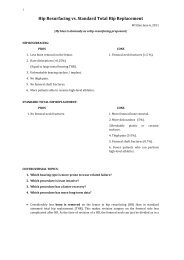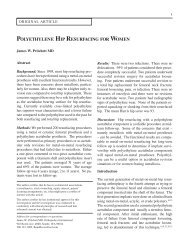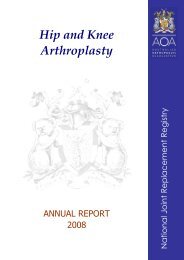Birmingham H ip Resurfacing v ersus C onserv e Plus M etal-on-M ...
Birmingham H ip Resurfacing v ersus C onserv e Plus M etal-on-M ...
Birmingham H ip Resurfacing v ersus C onserv e Plus M etal-on-M ...
You also want an ePaper? Increase the reach of your titles
YUMPU automatically turns print PDFs into web optimized ePapers that Google loves.
For example, Back and Shimmin in Melbourne, Australia reported 3.9 % of 230 BHRs squeaked.<br />
In my series I have 5.5% (48/871) squeaking <str<strong>on</strong>g>Birmingham</str<strong>on</strong>g>’s. In my C<str<strong>on</strong>g><strong>on</strong>serv</str<strong>on</strong>g>e plus series there are <strong>on</strong>ly 0.8% squeakers (5/667). Whether the difference<br />
is due to the higher clearance, different m<str<strong>on</strong>g>etal</str<strong>on</strong>g>lurgy or cup design in the <str<strong>on</strong>g>Birmingham</str<strong>on</strong>g> H<str<strong>on</strong>g>ip</str<strong>on</strong>g> <str<strong>on</strong>g>Resurfacing</str<strong>on</strong>g> has yet to be established.<br />
Recent articles in the San Diego Uni<strong>on</strong>-Tribune and the New York Times about squeaking ceramic total h<str<strong>on</strong>g>ip</str<strong>on</strong>g>s are worrisome to the orthopaedic<br />
practice (see page 22) because of the possible medicolegal issues and the impact <strong>on</strong> the patient; i.e. legal acti<strong>on</strong> against the surge<strong>on</strong>s and<br />
manufacturers<br />
Patients with squeaking h<str<strong>on</strong>g>ip</str<strong>on</strong>g> resurfacings should be reassured that unlike some of the noisy ceramics, their squeak will most likely resolve quickly. The<br />
possible negative effects of the squeaking h<str<strong>on</strong>g>ip</str<strong>on</strong>g> resurfacings are not known.<br />
Copyright Dr. Koen De Smet<br />
SUMMARY<br />
Although the <str<strong>on</strong>g>Birmingham</str<strong>on</strong>g> H<str<strong>on</strong>g>ip</str<strong>on</strong>g> <str<strong>on</strong>g>Resurfacing</str<strong>on</strong>g> and C<str<strong>on</strong>g><strong>on</strong>serv</str<strong>on</strong>g>e <str<strong>on</strong>g>Plus</str<strong>on</strong>g> systems have the l<strong>on</strong>gest clinical track records of the many sec<strong>on</strong>d<br />
generati<strong>on</strong> h<str<strong>on</strong>g>ip</str<strong>on</strong>g> resurfacing prostheses now available, most of the published knowledge and l<strong>on</strong>ger term follow-up reports c<strong>on</strong>tinue to be<br />
dominated by the surge<strong>on</strong> inventors and design centers. There are very few independent l<strong>on</strong>g-term studies and even fewer comparative<br />
studies of the two designs where the prostheses were d<strong>on</strong>e by the same surge<strong>on</strong>, in the same instituti<strong>on</strong>. In this booklet, I have tried to<br />
provide an extensive comparis<strong>on</strong> of the two products based <strong>on</strong> my 10 years of experience with more than 3000 resurfacings, a large number<br />
of revisi<strong>on</strong>s of referred cases and several years of collecting i<strong>on</strong> measurements and implant retrieval data.<br />
From this experience, I see several important differences between the two. As a resurfacing surge<strong>on</strong>, I want to take a c<str<strong>on</strong>g><strong>on</strong>serv</str<strong>on</strong>g>ative approach<br />
to the b<strong>on</strong>e stock, and an important goal is to keep the b<strong>on</strong>e for the next procedure; in this regard, the C<str<strong>on</strong>g><strong>on</strong>serv</str<strong>on</strong>g>e <str<strong>on</strong>g>Plus</str<strong>on</strong>g> provides a clear advantage<br />
because of less b<strong>on</strong>e removal from the pelvis as the comp<strong>on</strong>ents have always been available in 2-mm increments. This was not the<br />
case when the <str<strong>on</strong>g>Birmingham</str<strong>on</strong>g> H<str<strong>on</strong>g>ip</str<strong>on</strong>g> was first introduced although it is now also available in the smaller increments. This avoids the previous<br />
problems of excessive b<strong>on</strong>e removal from the pelvis that was often inevitable with the 4-mm increment sizing of the full hemispherical cup.<br />
Unfortunately for American surge<strong>on</strong>s, this problem of preserving b<strong>on</strong>e persists as <strong>on</strong>ly the 4-mm increments were approved by the FDA. Another<br />
b<strong>on</strong>e c<str<strong>on</strong>g><strong>on</strong>serv</str<strong>on</strong>g>ing design feature of the C<str<strong>on</strong>g><strong>on</strong>serv</str<strong>on</strong>g>e <str<strong>on</strong>g>Plus</str<strong>on</strong>g> is the smaller stem; the effects of l<strong>on</strong>g-term b<strong>on</strong>e remodelling around the thicker<br />
<str<strong>on</strong>g>Birmingham</str<strong>on</strong>g> H<str<strong>on</strong>g>ip</str<strong>on</strong>g> <str<strong>on</strong>g>Resurfacing</str<strong>on</strong>g> stem in small sized femoral heads remain to be seen.<br />
Retrieval and cadaveric studies have shown that there is a risk of cement over-penetrati<strong>on</strong> with both the <str<strong>on</strong>g>Birmingham</str<strong>on</strong>g> H<str<strong>on</strong>g>ip</str<strong>on</strong>g> <str<strong>on</strong>g>Resurfacing</str<strong>on</strong>g> and<br />
C<str<strong>on</strong>g><strong>on</strong>serv</str<strong>on</strong>g>e <str<strong>on</strong>g>Plus</str<strong>on</strong>g> cement techniques but with care, this can be avoided. From my extensive experience with both designs, it is clear to me that<br />
the cement clearance gap in the C<str<strong>on</strong>g><strong>on</strong>serv</str<strong>on</strong>g>e <str<strong>on</strong>g>Plus</str<strong>on</strong>g> allows easier and less traumatic femoral inserti<strong>on</strong>. This should be beneficial to reduce fracture<br />
risk, which remains the most comm<strong>on</strong> failure mode for most resurfacing surge<strong>on</strong>s.<br />
I c<strong>on</strong>sider the most important difference between the <str<strong>on</strong>g>Birmingham</str<strong>on</strong>g> H<str<strong>on</strong>g>ip</str<strong>on</strong>g> <str<strong>on</strong>g>Resurfacing</str<strong>on</strong>g> and the C<str<strong>on</strong>g><strong>on</strong>serv</str<strong>on</strong>g>e <str<strong>on</strong>g>Plus</str<strong>on</strong>g> to be that the BHR has more wear.<br />
This may be trivial in well-functi<strong>on</strong>ing prostheses but the wear difference becomes clinically significant when the BHR cup is not ideally<br />
placed, especially in a steep (> 50 degrees) positi<strong>on</strong>. This in turn leads to wear related failure modes that are <strong>on</strong>ly rarely reported with the<br />
C<str<strong>on</strong>g><strong>on</strong>serv</str<strong>on</strong>g>e <str<strong>on</strong>g>Plus</str<strong>on</strong>g>- problems such as “iliopsoitis”, groin pain, and the recently reported pseudotumors (Pandit et al, 2008).<br />
16






